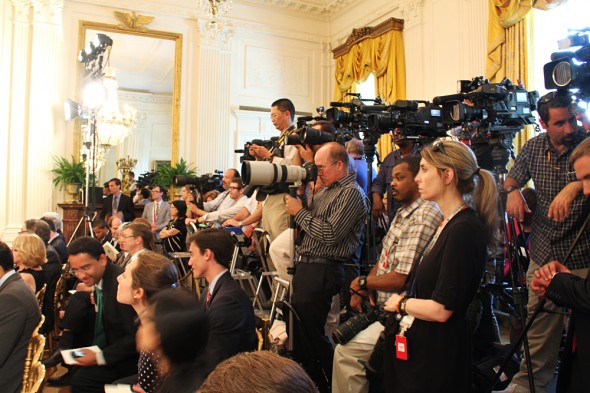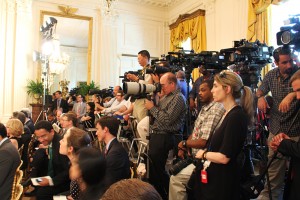WASHINGTON — There’s nothing quite as gratifying as a strong visual that boosts your storytelling. Here are some tips that might feel uncomfortable at first but becomes instinctive after a few times.
Be respectful, but disregard others. I’m not saying break the rules or get in others’ way for your benefit. Rather, lose the timidity. People will stare while you follow your subject through a museum with a video camera. A cranky man standing in the aisle of the media area at a White House event won’t switch spots with you even though he has no intention of taking photos or video. So politely ask the photographers in front of him if you can squeeze between them and get up there. For the most part if you communicate with them and don’t get in their way, most photographers will cooperate to make it work for everyone.
Which leads me to the next point.
Learn from the veterans. Everyone could tell I was a newbie the first time I covered a presidential event at the White House. The other photographers were from the networks and had been doing this for ages.
Barack Obama? No big deal. They see him (from afar) every week.
They graciously answered a few logistical questions I had, and they even offered to shoot my stand-up in addition to taking a picture of me on my phone with the president in the background. (There’s a first for everything. No shame in documenting!)
Survey the scene and get as close as possible. When I was at the Scripps National Spelling Bee, I initially thought video cameras were only allowed on the risers far, far away from the stage. After a few minutes of shooting, I spotted some photographers crouching in front of the judges directly by the stage and getting some awesome shots. I quickly made a bee-line for that area.
Otherwise, you might never know what the head judge at the Spelling Bee looks like.
Get ready to be uncomfortable. Do what it takes, even if it means playing human tetris and somehow fitting into a random space.
Keep shooting until they tell you to stop. Don’t ask. Just go. Until they stop you, that is. Unless you’re being a safety hazard, at an event with high-ranking officials or there are clear rules, people seem to leave you alone.





